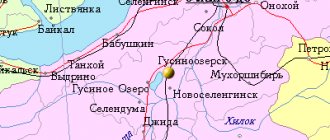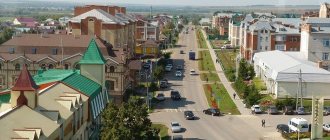General information
The city is located on the slopes of two ridges: Yablonovy and Chersky, at the confluence of the Chita River and Ingoda. Within Chita there is the Titovskaya Sopka mountain with a height of 946 meters, as well as Lake Kenon. The natural landscape is varied: from meadows and steppes to mountain taiga.
Chita is located in a zone of pronounced continental climate with little snow in winter and warm, humid summer. The distance from the capital of the Russian Federation, Moscow, is 5000 km.
Sights of the city of Chita
The city is famous for its sights, which preserve a long history.
The monument to love and fidelity was opened on July 8, 2011, on Family Day. A monument was erected at the intersection of Stolyarova and Amurskaya streets. The place for the sculpture was not chosen by chance. It was at the intersection of these streets that the wives of the Decembrists lived. The author of the monument is M. Albatasov. The sculpture represents a man and a woman who met after a long separation. The botanical garden was founded in 1990. It surprises with its huge exposition. All climatic conditions have been created for plants. The garden area is 27 hectares.
The zoo was opened on July 20, 1994. At that time there already existed a small zoo where roe deer, goats, peacocks and swans lived. These animals first appeared in Chita in 1986. By the time the large zoo opened, about 200 individuals had been collected. Some animals were picked up wounded in the forest, and some were taken from poachers.
The Alexander Nevsky Chapel was equipped in September 2001. Construction of the chapel lasted only a few months. The place for its construction was not chosen by chance; in 1891, Chita was visited by Tsarevich Nikolai Alexandrovich, who visited Titovskaya Sopka.
Chita Datsan is a Buryat Buddhist monastery located in Russia. It was opened in 2010, although the site for its construction was illuminated back in 2001.
The Kazan Cathedral is the main one in Chita. This temple is the decoration of the city. On June 21, 2002, the first liturgy was held in the church in honor of the Kazan Icon of the Mother of God.
From the history of the city
The appearance of Chita is associated with the development of the vast expanses of Siberia by service people. Moving deeper into the Siberian expanses following the Cossacks, a variety of merchant and industrial people walked. The detachment of Peter Beketov in 1653 reached the river. Ingoda and laid out the winter quarters. This settlement was called Plotbishche, because the construction of rafts and later boats was carried out here. Having an advantageous geographical location, being at the intersection of land and waterways, the Plotby developed rapidly. In 1699, a fort appeared, which in 1706 received the name Chitinsky.
The future city owes its further development to the development of silver mines in the surrounding area at the beginning of the 17th century, called Nerchensky, and the construction of factories. From the written sources of the 18th century that have reached us, we can find out the population of Chita at that time. In 1762 it was 73 inhabitants. The shortage of labor was made up by using convict labor.
Over time, the fort began to belong to the Nerchensk Mining Administration. This left its mark on employment. Chita continued its industrial development thanks to the fact that its residents began to burn charcoal to smelt ore, supplying it to the Shilkinsky plant. Forestry and rafting of cargo along the river were also common occupations of the local population.
In the 20s In the 19th century, the city already had 300 inhabitants. Chita became the center of the Chita volost. The Decembrists, who were exiled here to hard labor, played an important role in the development of the city.
In the middle of the 19th century, the Transbaikal region was formed. The title of its main urban center was given to Chita, whose population began to grow rapidly. In 1863, three thousand residents already lived here.
Chita entered the 20th century as a developed industrial city in Siberia. A railway was built, many factories and factories were operating. The settlement became a major trading center in Transbaikalia. Houses and temples were built, a synagogue and a mosque operated, and a library appeared. The population of the city by 1910 was more than 68 thousand people.
After the October Revolution, the city was for some time the capital of the Far Eastern Republic. During the Second World War, Chita enterprises worked for the needs of the front. In 1945, the headquarters of the Commander-in-Chief in the Far East, Marshal Vasilevsky, was located here. Until 1949, Japanese prisoners of war worked in the city on the construction of various buildings.
The city's social infrastructure developed. Chita, whose population worked hard at industrial enterprises and in the social sphere, was awarded the Order of the October Revolution in 1972.
Transbaikalia
Essay on the topic my city Chita
Chita is a city founded in the depths of Siberia by the Cossack Pyotr Beketov as a Cossack fortress. This happened during the development of distant lands by the Cossacks in the 17th century. The settlement was supposed to become an outpost of the Russian Empire on its way to the east, to East and Central Asia.
At first, the settlement was called Plotbishche, as it stood at the confluence of two rivers, and the main industry at that time in this place was the construction of rafts. The settlement received its current name later, after the Chita River, on which it stands. The main population were Cossacks and industrialists. The location on waterways contributed to the development of the settlement. In 1699, a fort was built here.
After the opening of the Nerchinsk silver mines, a need for labor appeared. Recruits began to be exiled to these places, then convicts, then Decembrists. Their wives and families followed the Decembrists, after which the population of Chita doubled. These places owe a lot to the Decembrists. It was these people who brought here real Russian culture and even, probably, the spirit of freedom and justice, which is still inherent in those living on this land.
We must not forget that before the arrival of the Cossacks, people also lived here, with their own history, culture, traditions and beliefs. Therefore, one of the goals that was set when establishing the settlement was to find ways to get closer to the indigenous population of these lands. This is the most difficult task, it can never be completed 100%. But life shows that if you strive for this, respect each other, take care of your own and other people’s heritage, then the future looks quite optimistic. Modern Chita with a population of about 400 thousand people is direct proof of this.
Chita today is a Russian city, with its successes, problems, disadvantages and advantages. In Chita there are 8 universities, 53 schools and a natural increase of 994 people per year (according to data for 2013). The most unpleasant thing is the crime rate and a large number of social problems. Industry – mining, engineering, metalworking, woodworking, light, food. Working population – 64%.
This is statistics. Of course, you can't argue with her. Maybe someone doesn't like her. But life is not always just numbers, life is people and their look into the future. From this point of view, Chita is a city looking towards tomorrow. People here are sincere in expressing their feelings and open to the bright and the good. Either it is the memory and wisdom of different peoples who can live in peace and respect for the moral values of others, or the land is so magical. There are no such people anywhere else.
Recently, in cultural and philosophical Russian circles there has been a tendency to search for a national idea and return to the roots. It may not be obvious yet, but interest in history is growing. Moreover, not only to classical history, but to legends, legends, folklore. About a year ago, an unusual musical performance “Children of the Otter” took place in Moscow. The author of the music is the philosopher-composer Vladimir Martynov. The performance is based on the works of Velimir Khlebnikov “Children of the Otter” and “Zangezi”. Musical suite is a combination of ethnicity, folklore, rock, jazz in the highest professional performance, with the participation of classical musicians and folk groups. The main idea is that we are all children of the otter, the mothers of all people living on our continent. We are all part of this continent, we have common roots, beliefs, and, accordingly, goals. And we have a common future; it simply cannot be any other way.
From this point of view, Chita is precisely the city in which many different faiths and peoples have merged, which has absorbed everything and, rich in this diversity of cultures, beliefs, people, looks to the future with optimism. This is a bright and sunny city with a great future.
Special thanks to Evgeniy Tseluiko for the materials provided.
Chita in the 21st century
Today Chita is a developed industrial city. The construction of objects of various importance has expanded, new foreign policy ties have been established, and trade is developing. Chita (the city’s population is especially proud of this) became the laureate of the prestigious national award “For worthy deeds - Grateful Russia”, the winner of the fourth All-Russian competition “Golden Ruble” in its district.
There are universities, schools, vocational guidance colleges, and research institutes in the city. Chita, whose population has the opportunity to raise its cultural level, has a sufficient number of educational institutions. There are 24 museums, theaters, a circus, a philharmonic society, and a large concert complex. Festivals and competitions of various levels are regularly organized and held.
“Convict Republic”: how the Decembrists turned Chita from a village into the capital of Transbaikalia
Decembrists on Senate Square
Chita old-timers like to tell visitors that the center of their city, with its straight streets, strongly resembles St. Petersburg, as it was designed by the Decembrists exiled here. They also like to show the main symbol of the city - the log Church of St. Michael the Archangel. Exiled opposition nobles and the women who followed them to Siberia were married there. Now the building of the temple houses the Museum of the Decembrists, which is popularly called simply the Church of the Decembrists.
"Convict Republic"
The first Decembrists arrived in the Chita prison at the end of January 1827. There were four of them: brothers Nikita and Alexey Muravyov, Ivan Annenkov and Konstantin Thorson. Later, during 1827 and 1828, about 70 more participants in the uprising were sent here. During three and a half years of hard labor, they gave the small settlement an impetus for development, which a quarter of a century later turned it into a city and the capital of the Trans-Baikal region.
“When the Decembrists first arrived in Chita, it was just a village of the factory department. Small, 75 wooden houses, 393 inhabitants. The Decembrists, of course, gave impetus to the development of this place,” Nadezhda Baranova, head of the Decembrist Museum, tells TASS. According to historian Mikhail Konstantinov, “despite the imprisonment, thanks to their unbending will and moral strength, the Decembrists actually created in Chita an island of free thought and spirit, a kind of convict Decembrist republic.”
The main part of the Decembrists were kept in a prison building they had completed - four rooms with small windows, where it was cramped, stuffy and noisy, including from the clanking of shackles. The prisoners were allowed to remove their shackles in August 1828 by special order of Emperor Nicholas I. Later they were allowed to build seven more small log houses in the prison yard at their own expense. There, in the prison yard of the Chita prison, the convicts built a building like a club, a gazebo, and planted a vegetable garden.
During their stay in the Chita prison camp, the Decembrists achieved the unspoken right to engage in science and education. They called their scientific meeting the “Convict Academy,” in which reports on the exact, natural and human sciences were heard, and mutual teaching of foreign languages, mathematics and crafts was practiced.
“The artist Nikolai Bestuzhev left watercolors with views of Chita and its environs, the Decembrist Pyotr Falenberg left a topographical plan of the fort, and Ferdinand Wolf conducted a medical practice here and organized smallpox vaccination for the first time in the region. Three and a half years, and so many things have been done,” notes Baranova.
Prison in Chita, where some of the Decembrists were kept.
Watercolor by Nikolai Bestuzhev, 1830. The Decembrists introduced the local population to vegetable gardening, gardening, and floriculture. Adults and children from the Chita prison district participated in concerts and group singing they organized. Prisoners organized literary readings and held chess tournaments in the prison. Involving teenagers in their studies, the Decembrists collected mineralogical, botanical, zoological, archaeological and numismatic collections. Sergei Trubetskoy conducted meteorological observations here.
"In the depths of Siberian ores"
In February 1827, Alexandra Muravyova, the wife of Nikita Mikhailovich, arrived in the Chita prison. She secretly brought Pushkin’s famous message “In the depths of Siberian ores” to the Decembrists. Here, in Chita, Alexander Odoevsky, on behalf of all the Decembrists, wrote a response to the “sun of Russian poetry,” which contains the famous lines: “Our sorrowful work will not be lost, a flame will ignite from a spark.”
A year later, in January 1828, Alexandra Muravyova conveyed another Pushkin message - “My first friend, my priceless friend,” addressed to Pushkin’s lyceum friend Ivan Pushchin.
The wives and brides of the exiles took several months to reach the Chita prison. Among them were princesses Maria Volkonskaya and Ekaterina Trubetskaya, the general’s wife Natalya Fonvizina, maid of honor of the Imperial Court Elizaveta Naryshkina - noble, educated women.
Perhaps the most romantic story is the wedding in the same St. Michael the Archangel Church of the French milliner Polina Gebl and her lover Ivan Annenkov, for whom the girl traveled a long way to Transbaikalia. After the sacrament, the young couple was greeted by the ringing of the shackles of all those present at the Decembrist wedding. Their love story inspired Alexandre Dumas' novel The Fencing Teacher.
The walls of this temple are also remembered by another marriage - the Decembrist Dmitry Zavalishin and Apollinaria Smolyaninova, a local resident, the daughter of a mining engineer. They got married in Chita in 1839, when Dmitry Irinarkhovich was allowed to settle.
“The wives of the Decembrists did a lot for our city. They started vegetable gardens here, attracting local craftsmen, and built log huts,” said the head of the Decembrist Museum. Next to the museum there is an architectural monument - the house of Elizaveta Petrovna Naryshkina; now it is a library.
First investment
According to local historian, candidate of philosophical sciences Andrei Bukin, the Decembrists “were the first involuntary, but high-quality investment in the development of Transbaikalia.” “The funds spent here by them and their wives shook up the economy and commodity production and became the basis for the development of the territory. The Decembrists largely predetermined the cultural development of the region and reflected in distant provincial Chita memories of the splendor of the imperial capital. Chita, by and large, lives by this reflection to this day,” he is sure.
“When talking about assigning Chita the status of a volost city, one cannot fail to mention Dmitry Zavalishin. He did a lot to prove that the geographical location of Chita allows it, and not Nerchinsk (the oldest city in the region - TASS) to be the center of the Trans-Baikal Territory,” Baranova noted.
Indeed, having returned to Chita in 1839, the exiled settler Zavalishin started an exemplary peasant farm here, began breeding and acclimatizing vegetables and fruits, and distributed seeds ordered from Central Russia to peasants and Cossacks for free. In a word, he behaved like a real colonist trying to settle distant lands.
The shackles in which the Decembrists were imprisoned.
Exhibit of the Decembrist Museum in Chita “Zavalishin studied medical manuals, prepared medicines from collected and grown medicinal herbs and distributed them to those in need. In his house he built a building for a school, where he taught willing children and adults, and then achieved the opening of several schools for peasant and Cossack families in Chita. He actively participated in drawing up the plan of Chita as a cartographer and land surveyor,” says the multi-volume “Encyclopedia of Transbaikalia” about him.
In 1851, it was Zavalishin who became one of the organizers of the celebrations dedicated to giving Chita the status of a city and regional center. The decree about this was read out from the porch of the Archangel Michael Church. And even after the amnesty that took place in 1856, Dmitry Irinarkhovich remained in Chita for another seven years, watching how the tiny village, which received the first Decembrists in January 1827, turned into the most important city in the east of the Russian Empire.
Chita
(Transbaikal region)
OKATO code:
76401
Founded:
1675
City since:
1851 City of regional subordination
Center:
Trans-Baikal Territory
Center:
Chita district
Urban areas, population as of 01/1/2021
| Railway | 47.0 | Central | 123.5 |
| Ingodinsky | 88.6 | Chernovsky | 91.8 |
| Telephone code (reference phone) | |
| 3022****** | — |
Deviation from Moscow time, hours:
6
Geographic latitude:
52°02′
Geographic longitude:
113°30′
Altitude above sea level, meters:
670 Sunrise and sunset times in the city of Chita
Culture, museums and theaters of Chita
One of the main cultural attractions of Chita are its museums. Trans-Baikal Regional Museum of Local Lore named after. A. Kuznetsov, opened in 1895, is the oldest museum in Siberia. The museum's collections, numbering more than 170 thousand exhibits, tell about the history and nature of the Trans-Baikal region, contain collections of minerals, household items and beliefs of the indigenous population (Evenks and Buryats), and works of fine art. The Chita Art Museum presents exhibitions of paintings, engravings and graphics by Transbaikal artists, works of decorative and applied art of the northern peoples. Separately, it is worth noting the Museum of the Decembrists, which is located in the Archangel Michael Church, better known as the Church of the Decembrists. The exhibition, dedicated to the period of the Decembrists’ stay in Siberia, reveals their significant role in the study of the region, cultural and educational activities. The museum hosts literary and musical meetings, theatrical performances, and “Decembrist Evenings” are held annually. Also of interest: Geological Museum, Art Gallery, Museum of Military Glory of the Siberian Military District, Museum of the Trans-Baikal Railway. The theatrical art of Chita is represented by productions of: the Transbaikal Regional Drama Theatre, which has repeatedly become a laureate and diploma winner of all-Russian and international competitions and festivals, the Puppet Theater “Far Far Away”, the Theater of National Cultures “Transbaikal Patterns”, the Folklore Theater “Zabaikalye”, the Song and Dance Theater “Amar” sain" and others.
Flag
The flag of Chita is a rectangular panel divided into four elements. The ratio of the width of the flag to its length is 2:3. In the pole part of the flag there is a yellow triangle, adjacent to which are equal-sized horizontal stripes of green, white and red. Where yellow (gold) is a symbol of wealth and justice; red (scarlet) – a symbol of courage, bravery and fearlessness; green is a symbol of hope, joy and abundance; white (silver) is a symbol of purity, perfection and independence.










